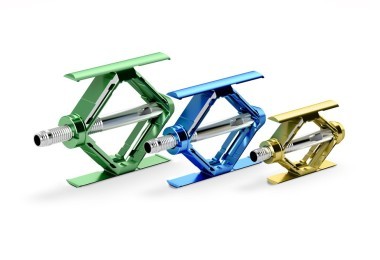
PARIS – Holistick Medical SAS reported a $5 million round for development of the first generation of a light-activated implant for a patent foramen ovale (PFO). Truffle Capital provided the startup with $4.6 million, while Bpifrance provided $470,000 in non-dilutive funding.
“This robust financing provides us with the resources needed to catapult our strategy forward and reinvent the treatment of heart defects such as PFO, which can be associated with occurrence of stroke in young people,” Boris Warnack, CEO of Paris-based Holistick Medical, told BioWorld.
PFO affects 1 in 4 people worldwide The foramen ovale is a vital passageway between the two atria of the heart during the fetal development stage, which in most cases closes during the first year of life. A PFO is a failure of this passage to close. This septal anomaly features in 25% of the population, responsible for some 50,000 new patients each year in Europe and 70,000 in the U.S. Boris Warnack, CEO, Holistick Medical SAS
A link has been observed between the presence of PFO and the occurrence of stroke in some patients, particularly in those below the age of 60. “PFO is believed to be present in half of all cryptogenic strokes, and randomized trials published in late 2017 demonstrated the benefits of PFO closure in patients who have suffered cryptogenic strokes,” said Warnack. The European Stroke Organization and the American Academy of Neurology have recommended PFO closure since 2016. In 2018, the European Association of Percutaneous Cardiovascular Interventions also published a consensus position paper on PFO closure in carefully selected patients aged 16 to 65 years with a confirmed history of stroke, transient ischemic attack or cryptogenic systemic embolism.
A technology transfer from Harvard and MIT
However, current solutions based on metal umbrella-like devices deployed on either side of the PFO have serious clinical limitations. Their rigid structure can provoke an allergic response to metals. “They can erode cardiovascular tissue and lead to transient atrial fibrillation or even perforation of the heart wall, embolisms and microthrombosis,” said Maelle Bruneau, vice president marketing and operations at Holistick. In addition, the metal occlusion systems currently on the market block transseptal access for later surgical procedures, particularly on the mitral valve, said Warnack. Hence why teams of research scientists and doctors at Harvard, the Massachusetts Institute of Technology (MIT), Boston Children's Hospital and Brigham and Women's Hospital came up with the idea of “a new generation of atraumatic implant that does not deteriorate in the long term,” said Philippe Pouletty, CEO and co-founder of Truffle Capital.
The American team, led by Ellen Roche, has developed patented light-reflecting technology for adhesive patch-mediated defect closure in challenging biological tissues. Thanks to a patch coated with a photocurable adhesive, their catheter-based device can achieve patch-to-tissue adhesion by transmitting, reflection and spreading UV light. There is no mechanical anchoring, and it works without leaving any permanent foreign materials in the body. This is because the patch is colonized by heart cells.
Truffle Capital invests $9.4M in Holistick’s R&D
In 2017, Truffle Capital created Holistick, whose aim is to develop a minimally invasive medical device for PFO closure. “We purchased a worldwide exclusive license for the technology from Harvard University and MIT, and worked on patenting to develop the medical device,” said Pouletty. To date, Truffle capital has completed three funding rounds for Holistick. This made it possible to devote $9.4 million to Holistick's R&D. In conjunction with an international medical advisory board of cardiologists and neurologists, the 10 or so mechanical engineers and biologists specializing in biomaterials have developed a new medical device for PFO closure that is protected by two patent families.
Holistick’s flexible occlusion system is the first light-reflecting balloon catheter for atraumatic heart tissue defect repair. The device comprises a catheter through which an internal fiber optic delivers UV light to a reflective balloon. The light is reflected onto a patch precoated with photocurable adhesive. “At 20 mm in diameter, our patch is the size of a two-euro coin, and it’s just 110 μ thick,” said Warnack. The adhesive attaches the patch onto the septal wall. This adhesive and the flexible textile adhere only to the right side of the heart. “In the longer term, the UV-activated patch is biodegradable because it is colonized by endocardial cells,” said Pouletty.
A market worth nearly $120M
The proof of concept for this new generation of septal occluder was completed at the end of 2020 via studies on half a dozen pigs, in which the implanted patch was followed up for three months. This $4.5 million capital raise will enable Holistick to launch long-term animal studies, lasting one year, on around thirty pigs. From the data collected from this preclinical study, we will prepare for clinical trials on human subjects, scheduled to start in mid-2022,” said Warnack. Holistick Medical is hoping to obtain CE marking in 2025. Last year, the Holistick team approached the FDA to prepare the ground for an early feasibility study.
The company is targeting a young population below the age of 60 who have already suffered a stroke, and in whom closure of the PFO is strongly indicated by professional associations. An annual market which Holistick claims is worth nearly $120 million. According to 360 Research Reports and Inside Market Reports, the stroke prevention market will see a compound annual growth rate of 14.9% over the next 10 years, exceeding $350 million in 2030. Holistick faces three major direct competitors in their field: Abbott Laboratories, with its Amplatzer PFO Occluder, CE marked and FDA approved in October 2016; W. L. Gore & Associates Inc., with its Cardioform Septal Occluder, CE mark and FDA approved in 2018; and Occlutech International AB, with its PFO Occluder which was CE marked in 2017. Unlike its competitors, who offer rigid metallic or semi-metallic discs, “our Holistick polymeric flexible implant does not cause any erosion of heart structures or blockage of the atrial septum, allowing it to be re-crossed in any future procedures,” said Warnack and Bruneau.
A new indication coming for chronic migraine with aura
Holistick is already targeting another indication, patients with chronic migraine with aura. In France alone, there are an estimated 7,325 new cases of chronic migraine with PFO each year. This translates to 95,000 in Europe and the U.S.
Holistick is part of Truffle’s original industrial strategy. Truffle Capital is currently launching Truffle Medeor, its second $950 million venture capital fund for med-tech companies. Majority shareholders in several med-tech companies, Truffle Capital brings some of them together to combine technologies “as we have already done for Abbivax, currently with a market cap at $350 million, and Medical Affluent, formed in 2018 from the merger of four companies in our portfolio,” said Pouletty. Bringing together the colonizable patch from Holistick, biodegradation technology from Pkmed SAS and magnetically guided microrobots from Artedrone SAS could give rise to a new kind of surgical platform.



